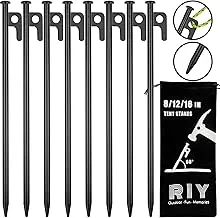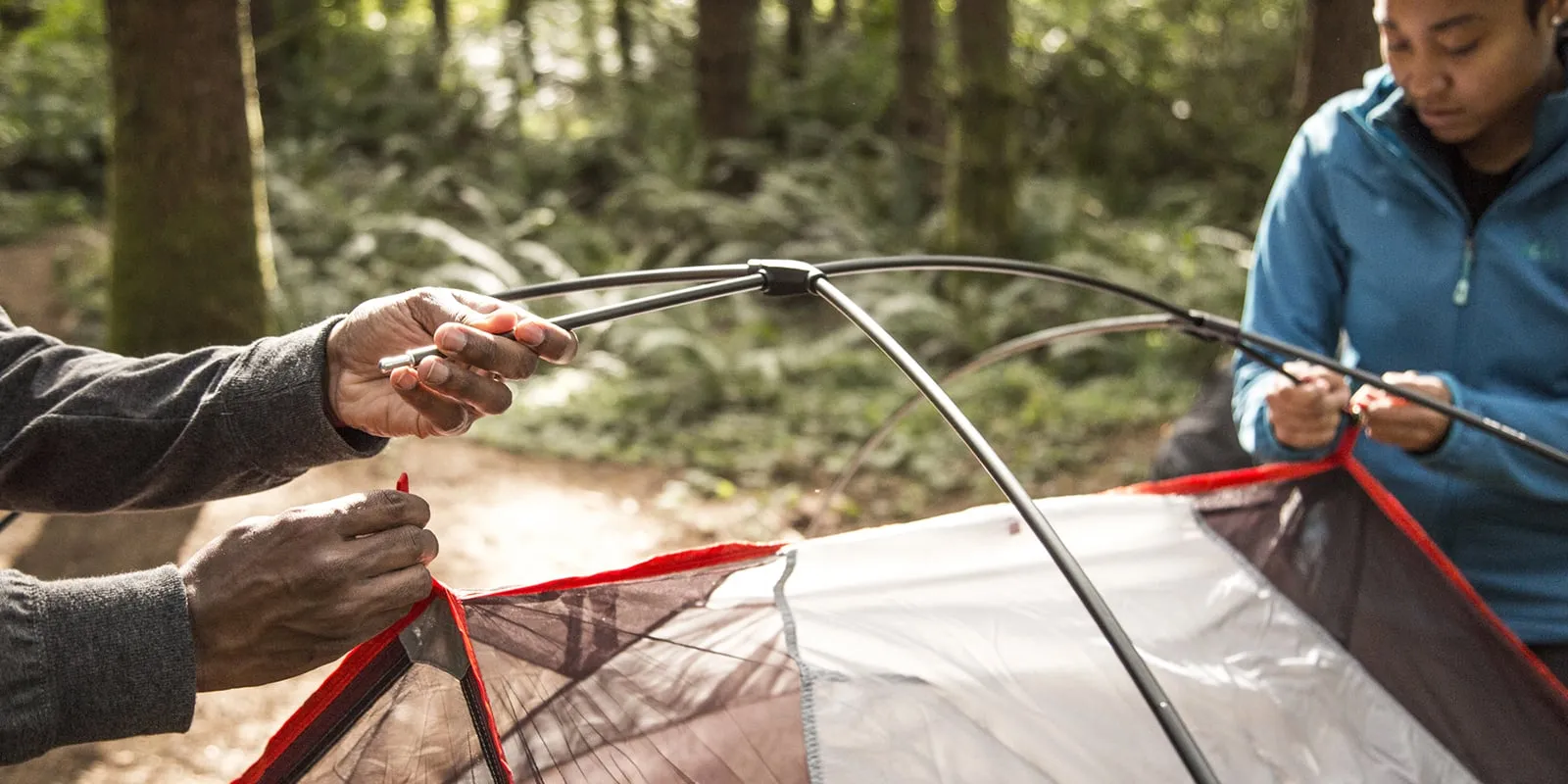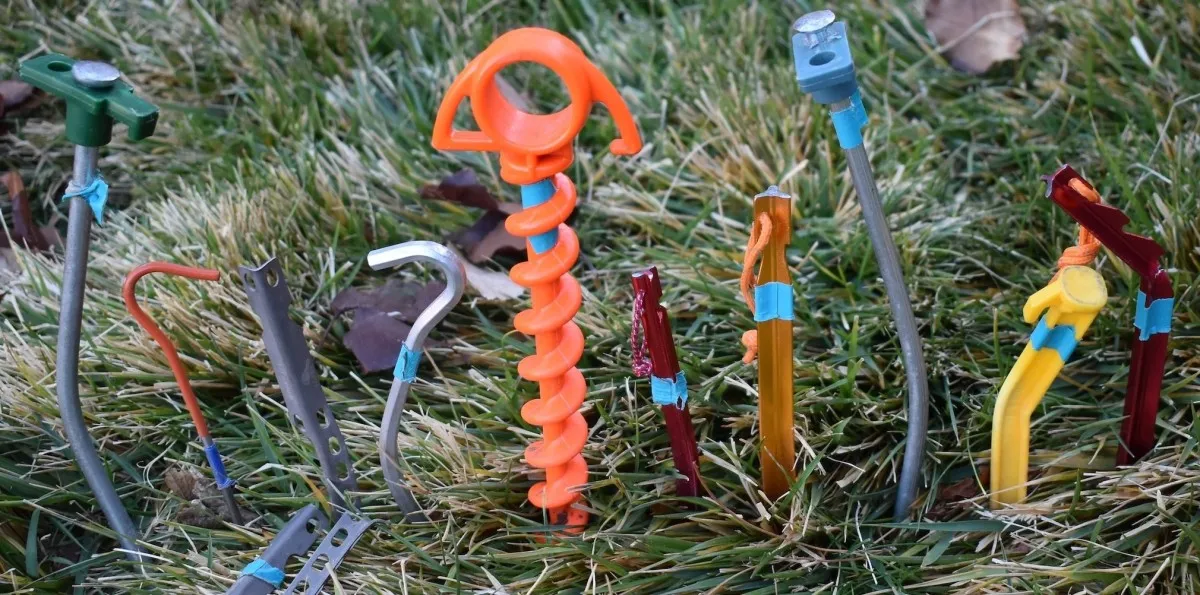If you're wondering "does my tent come with stakes?" - the answer is almost always yes! However, the quality and suitability of these included stakes often leaves much to be desired. Through my years of camping across diverse terrains from rocky mountain peaks to sandy beaches, I've learned that upgrading your tent stakes is one of the most important gear improvements you can make. This comprehensive guide will explain everything you need to know about tent stakes, what comes with your tent, and how to choose the best ones for your adventures.
Do Tents Come With Stakes? The Simple Answer
.webp)
When people ask "does my tent come with stakes?", I can confidently say that virtually every tent manufactured today includes a set of stakes in the packaging. During my 15+ years of camping and testing gear, I've never encountered a tent that didn't come with some form of staking system. However, the real question isn't whether your tent comes with stakes - it's whether those stakes are actually worth using.
The stakes included with your tent are typically the most basic, cost-effective option the manufacturer could source. Whether you're purchasing a budget tent from a big-box store or a premium backpacking shelter, the included stakes are usually an afterthought in the design process. Most tent manufacturers focus their budget and attention on the tent fabric, poles, and construction, leaving stakes as a necessary but minimal inclusion.
In my experience camping across different terrains - from the rocky soil of Colorado's high country to the sandy beaches of the Pacific Coast - I've learned that the question "does my tent come with stakes" should really be "does my tent come with good stakes?" The answer to that is almost always no.
Most tents include enough stakes to secure all the main attachment points, plus usually one or two extras. A typical 2-person tent might come with 8-12 stakes, while larger family tents can include 20 or more. The quantity is rarely the issue - it's the quality and appropriateness for your specific camping conditions that matters most.
Pro Tip: Even if your tent comes with stakes, I always recommend having a backup plan. Knowing alternative staking methods can save your camping trip when stakes fail or break.
What Type of Stakes Do Tents Include?
Understanding what type of stakes your tent includes helps answer the broader question of "does my tent come with stakes" that are actually useful. The type of stakes included typically depends on the tent's price point and intended use.
Steel Shepherd's Hook Stakes
Most budget and mid-range tents come with basic steel shepherd's hook stakes. These L-shaped stakes are inexpensive to manufacture and work adequately in firm soil. However, they bend easily, rust over time, and struggle in rocky or sandy conditions.
Best for: Firm soil, car camping
Aluminum Stakes
Higher-end tents, especially backpacking models, often include basic aluminum stakes. These are lighter than steel but can be just as flimsy. The quality varies significantly between manufacturers.
Best for: Weight-conscious backpacking, mild conditions
Plastic Stakes
The cheapest tents sometimes include plastic stakes, which are essentially useless in any challenging conditions. I've seen these snap just from normal insertion into moderately firm soil.
Best for: Very soft soil only (not recommended)
When I purchased my first quality backpacking tent, I was surprised to find it came with relatively decent aluminum stakes. However, during a camping trip in the White Mountains, these "adequate" stakes bent when trying to secure my tent in the rocky New England soil. This experience taught me that even when the answer to "does my tent come with stakes" is yes, those stakes might not be suitable for your specific camping environments.
The length of included stakes also varies significantly. Most range from 6 to 9 inches, with longer stakes generally providing better holding power. Understanding what your tent package includes helps you prepare for upgrades before your first camping trip.
Why You Should Upgrade Your Tent Stakes

While the technical answer to "does my tent come with stakes" is almost always yes, the practical reality is that these stakes often fail when you need them most. I learned this lesson the hard way during a camping trip in Utah's red rock country, where the included stakes simply couldn't penetrate the hard-packed desert soil.
Problems with Factory Stakes
Common Issues I've Encountered:
- Bending and Breaking: Cheap stakes bend at the first sign of resistance, especially in rocky soil
- Poor Holding Power: Inadequate surface area means stakes pull out easily in wind
- Rust and Corrosion: Steel stakes rust quickly in humid conditions
- Wrong Design: One-size-fits-all approach doesn't work for diverse camping conditions
- Weight Penalties: Heavy steel stakes add unnecessary weight to backpacking kits
The stakes that come with your tent are designed to work adequately in ideal conditions - soft, loamy soil with no wind. In my experience, ideal camping conditions are rare. Whether you're dealing with rocky mountain soil, sandy beaches, frozen ground, or high winds, factory stakes often fall short.
I remember one particularly windy night in Colorado where my tent's included stakes simply couldn't handle the gusts. The stakes pulled out repeatedly, and I spent half the night re-securing my shelter. Since upgrading to quality stakes, I've never had a tent failure due to inadequate anchoring.
Best Tent Stakes for Different Conditions
Now that we've established that while the answer to "does my tent come with stakes" is yes, those stakes are often inadequate, let's explore the best upgrade options. Through extensive field testing across various terrains, I've identified the top stake choices for different camping scenarios.
Amazon Recommendations
MSR Groundhog Stakes
The gold standard for all-around performance. These Y-beam aluminum stakes work excellently in most soil types and are my go-to recommendation for upgrading from factory stakes.
Weight: 14g each | Length: 7.5" | Material: 7075-T6 Aluminum
MSR Mini Groundhog Stakes
Perfect for ultralight backpacking, these shorter stakes maintain excellent holding power while saving weight. Great for when you need to count every gram.
Weight: 11g each | Length: 6" | Material: 7075-T6 Aluminum
Big Agnes Dirt Dagger UL Stakes
Innovative I-beam design provides exceptional strength-to-weight ratio. These are my choice for challenging alpine conditions where stake failure isn't an option.
Weight: 9g each | Length: 6" | Material: 7075-T6 Aluminum
Vargo Titanium Shepherd's Hook
Ultra-lightweight titanium construction makes these perfect for gram-counting backpackers. Incredibly strong despite their minimal weight.
Weight: 8g each | Length: 6.5" | Material: Titanium
Kelty Sand Bag Stakes
Unique solution for beach camping and loose soil conditions. Fill with sand or rocks for secure anchoring when traditional stakes won't work.
Weight: 56g empty | Capacity: 20 lbs | Material: Durable nylon
My Personal Recommendation
After testing dozens of stake types across various conditions, I recommend starting with MSR Groundhog stakes as your primary upgrade. They offer the best balance of weight, strength, and versatility. For specialized conditions like sand or hard-packed soil, add specific stakes to your kit. Remember, the goal isn't to replace every stake your tent comes with, but to have the right tools for your specific camping environment.
How to Properly Use Tent Stakes

Knowing that your tent comes with stakes is just the beginning - understanding how to use them properly is crucial for a successful camping experience. Even the best stakes won't perform if they're used incorrectly. Through years of camping and learning proper staking techniques, I've developed a systematic approach that maximizes holding power regardless of conditions.
Essential Staking Principles
1. Proper Angle
Drive stakes at a 45-degree angle away from the tent. This maximizes holding power by utilizing both soil friction and mechanical advantage.
2. Full Insertion
Insert stakes completely until only the attachment point is visible. Exposed stakes create leverage points that reduce holding power.
3. Tension Management
Maintain consistent tension on guylines. Loose lines create dynamic loading that can pull stakes out during wind gusts.
4. Strategic Placement
Position your tent to use natural windbreaks and place critical stakes in the most stable soil available in your campsite area.
During a memorable camping trip in Wyoming's Wind River Range, I learned the importance of proper stake technique when 40+ mph winds tested every aspect of my setup. The combination of quality stakes and proper placement kept my tent secure while others in the area struggled with failures.
One crucial lesson I've learned is that the question "does my tent come with stakes" extends beyond just having them - it's about having enough stakes for all conditions. I always carry 2-3 extra stakes beyond what my tent requires, as losing or breaking a stake in challenging conditions can turn a great camping trip into a survival situation.
Pro Tip: When camping on wooden platforms or areas where staking isn't possible, learn alternative securing methods using guy lines and available anchor points. This comprehensive guide covers various scenarios you might encounter.
Proper maintenance of your stakes is equally important. After each camping trip, I clean my stakes thoroughly, check for damage, and ensure pull-cords are in good condition. Quality stakes can last for years with proper care, making them one of the best camping gear investments you can make.
Conclusion
So, "does my tent come with stakes?" Yes, it almost certainly does. But as we've explored throughout this comprehensive guide, the real question is whether those stakes will serve you well in the diverse conditions you'll encounter while camping.
From my extensive experience camping across various terrains and weather conditions, I can confidently say that upgrading your tent stakes is one of the most impactful gear improvements you can make. The difference between a secure, comfortable night and a stressful battle with your shelter often comes down to having the right stakes for your specific camping environment.
The stakes included with your tent are designed to work adequately in ideal conditions, but ideal conditions are rare in the real world. Whether you're dealing with rocky mountain soil, sandy beaches, frozen ground, or high winds, having quality stakes designed for those specific challenges will dramatically improve your camping experience.
Remember that tent stakes are a safety issue as much as a comfort one. A tent that fails during severe weather can put you at risk, while a properly secured shelter provides the protection you need to enjoy the outdoors safely. Investing in quality stakes is investing in your safety and peace of mind.
Start with a good set of all-purpose stakes like the MSR Groundhogs, then build your collection based on the specific conditions you encounter most often. Your future camping self will thank you for making this essential upgrade.
Ready to upgrade your camping setup?


